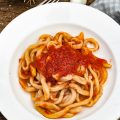The Studio, a Bertazzoni stove and Grandma’s lasagne
It was about this time of the year. Last December we started scribbling down the project of a studio on a piece of yellow paper during a dinner in a local trattoria. We didn’t pay much attention to the food nor to the surrounding noisy tables. We were focused on a dream, or better, a project. It had measures, estimated costs, a rough time schedule and a crammed Pinterest board for inspiration. We had a starting point, the modern heart of the studio, a red, 90cm large, six burner Bertazzoni stove with an electric oven.

Bertazzoni, the first sponsor of the Studio, gave us to option to choose what would suit us better and we opted for a grand oven where I could easily roast a Thanksgiving turkey for a bunch of American friends, for 6 burners, so that during my cooking classes I could juggle in between pots of boiling water, saucepans of simmering sauces and pans where I would sauté seasonal vegetables.

If we debated about the electric oven and the number of burners for quite some time, Tommaso and I agreed at once on the colour, a warm, deep, rich burgundy red, a fully durable, double layer coating using the latest processes developed for the automobile industry. This is what Tommaso mentions every time during cooking classes, proud to host in his studio a stove which has been painted with the same method used for a sports car.
It is the magnetic pole of the Studio, it captures everyone’s eyes, especially as we decided to frame it with white wooden kitchen cabinets and rustic open shelves.

At the beginning we thought we would keep it clean, minimal, chic: just a few jars and some bowls. Then my style crept in. If you see me minimal and chic are definitely not the first adjectives that come to your mind: warm, maybe practical. Now the kitchen is neatly organized but full of props, jars, tea and coffee cups, wooden boards, baskets of nuts and fresh fruit, cookery books.

Facing the Bertazzoni stove, the modern heart, my grandma’s old cast iron stove, the ancient heart of the studio. It is a constant in my childhood memories: tiny, heavy, black, scorching hot, it used to burn basketful of wood, permeating the house with an ancient heat. Now it faces my Bertazzoni stove, it heats the Studio, a pot of water for tea, my back when I sit down to write.


On a side, washed by daylight, there is a simple bookcase where I collected my favourite cookery books. During every meal, either with friends or with guests, we suddenly start talking about cookbooks and we find ourselves browsing through the collection, picking our favourite titles and sharing suggestions and recipes.
Next to it a turquoise cart to hold spices, bottles of olive oil and vinegar, home-made liqueurs and jars of grains and cereals.

Huge French windows open the Studio to the farmyard. This is something I was adamant about: I wanted a continuous exchange with the outside, with the garden, the trees, the Nature.
It is my main source of inspiration, I need to see the colours change, the light kissing the trees in the distance. Pots of plants and herbs help to reinforce this continuous exchange: green inside and outside.


The Studio is also a place to gather with friends and family. When I am overwhelmed by recipes to cook and test, I call my mum or my grandma for help, and in no time we’re there again, around a table, chatting and cooking, a timeless scene so comforting and reassuring.
This is where I asked nonna to teach me a special cooking class. After Grandma taught me how to make fresh pasta, choux pastries and ragout, it was time to learn all the secrets behind her killer lasagne. All the family love it to bits, it is a sacred unmissable appointment for holiday meals and birthday celebrations.

Grandma’s Tuscan lasagne
It is quite unique, as it is not the Bolognaise recipe, but her own version, made with béchamel sauce, her Tuscan ragout, mozzarella and paper thin sheets of fresh pasta.
I followed her layer after layer, learning the importance of balancing the ingredients, spreading the béchamel and the ragout with a wooden spoon as to cover the entire surface, without exceeding with quantities.
With the holidays approaching, this is the first recipe you can bookmark for a special Tuscan Christmas meal.

Follow this recipe to make the ragù. You can either use or omit the dried mushrooms for the lasagne. Halve the quantity for the lasagne we’re making today, or cook the whole batch and freeze leftovers for future Sundays when you’ll want a grand meal with no effort at all.
Grandma's lasagne
Print Recipe Pin Recipe Share by EmailIngredients
Fresh pasta
- 150 g of all purpose flour
- 150 g of durum wheat semolina flour
- 1 pinch of salt
- 1 tablespoon of extra virgin olive oil
- 3 medium eggs
Béchamel sauce
- 50 g of butter
- 60 g of flour
- 800 ml of milk
- 1 pinch of salt
- Grated nutmeg
Lasagne
- Meat sauce
- 400 g of fresh mozzarella
- 80 g of grated Parmigiano Reggiano
- Breadcrumbs
- Butter
Instructions
Prepare fresh pasta
- Sift the flour with the semolina flour, pour them on a wooden board and make a well in the middle.
- Break in the eggs and add a good pinch of salt and a tablespoon of olive oil.
- Mix the flour and the eggs with a fork until crumbly, then knead the dough, adding cold water if needed.
- After a while the dough should have the right consistency: smooth, velvety and no longer sticky.
- Wrap it in plastic film and let it stand for 30 minutes at room temperature.
Prepare the béchamel sauce
- Melt the butter in a saucepan. When melted, spoon in the flour and whisk for a few minutes until golden and toasted.
- Pour in the cold milk in a thin stream, stirring constantly to avoid lumps.
- Let cook the béchamel sauce for a few minutes until thickened and season with a good pinch of salt and grated nutmeg.
Now prepare the lasagne
- Heat oven to 200°C.
- Roll out the dough into paper thin sheets of pasta. Leave the pasta sheets on a tablecloth dusted with semolina flour and prepare all the ingredients for the lasagne.
- Spoon some of the meat sauce on the bottom of a large tray, then line it with enough sheet of pasta to cover it. Spoon the béchamel and spread it evenly over the pasta, then spoon the meat sauce and spread it. Sprinkle with grated Parmigiano Reggiano. Tear the mozzarella into bite sized morsels and scatter it onto the lasagne. Cover the mozzarella with sheets of pasta, and repeat for seven layers.
- Finish with béchamel sauce, meat sauce, mozzarella, a good dusting of Parmigiano Reggiano and breadcrumbs, for a nice and golden crust. Add a few slivers of butter and bake for about 30 minutes, or until golden brown and bubbling.
- Serve immediately, or, better, let it rest and reheat before serving.

 Ciao! Questo contenuto è disponibile anche in Italiano.
Ciao! Questo contenuto è disponibile anche in Italiano. 




Ciao, why do you not boil the dough.
Se la faccio cosi` sento il sapore della farina, perche`
Grazie.
Alex
Thanks, Juls, for this lovely tour of your studio—what a warm, enchanting place! I love your Bertazzoni stove! In our kitchen in Florence we have one of the cramped Smeg stoves that so ubiquitous in Italy and I dream of having a stove like yours! Thanks, also, for your grandmother’s lasagna recipe, I’m looking forward to making it during the days approaching Christmas. Did she roll out the pasta by hand? I imagine so from the looks of that pasta board.
And an overall thanks as always, for your beautiful, lyrical, and of course, practical blog. As I’ve said before, I don’t always comment, but I enjoy the postings immensely and read every one from beginning to end. Warm holiday wishes to you. —Bob
The range is nice, but the much older cast iron stove takes the cake. Bellissima!
I loved the tour of your studio! The new stove is fantastic — six burners! The first thing we did when we moved into our downsized house was to put in a double oven. We do so much baking we couldn’t do without it. And your nonna’s lasagna recipe looks wonderful. I’ll have to try her version. Grazie!
What a warm and welcoming place to spend time with family & friends or create. Wishing you all the best as you continue to move forward with your dream.
What a lovely cooking studio Giulia! Thank you for taking your readers on a virtual tour of your inspiring space. The natural Tuscan light that floods your space is incredible. I hope to attend one of your classes someday so we can finally meet in person!
This is my go to recipe for lasagna. It is amazing and loved by everyone I have served it to. I’ve probably made it 10 times or more (along with the ragu.) You are right that it’s important not to over do the contents of each layer. I wish there was a way to be more exact, I never quite do it the same way twice! Thank you for your recipes, they are all wonderful.
And the thing that is never the same is a beautiful thing, it means it is truly homemade!
All of your recipes are 5 Stars. I have produced a cookbook for family and friends and it is now overflowing with printouts from your blog. My husband, Rocco, has requested lasagna for Easter this year. I have my recipe, but always look for tips from your site. I am making the pasta fresh this year and your recipe does not boil the pasta before layering. Is this correct? I will definitely follow your lead.
Hello Deborah, thank you so much! Yes, I do not boil the pasta when I make it fresh because I tend to make the béchamel sauce slightly runnier and the pasta very thin, so it cooks directly in the oven. Let me know how it turns out, and Happy Easter!
My Easter lasagna was best ever. Your pasta recipe and no boil tip was perfect. My husband couldn’t be happier. Thank you for your beautiful blog and Happy Easter to you also.